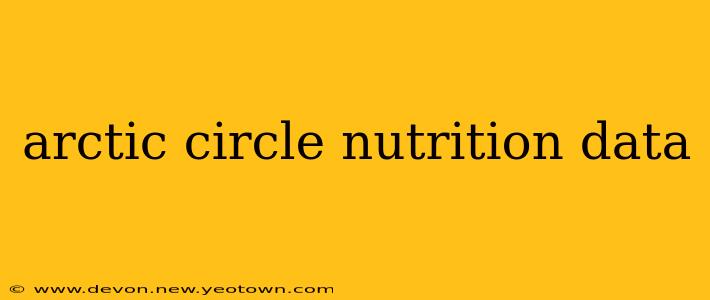The Arctic Circle, a land of breathtaking beauty and harsh conditions, presents a unique challenge when it comes to nutrition. This isn't just about surviving the cold; it's about understanding the nutritional landscape shaped by limited resources, specific food sources, and the cultural practices of the indigenous populations who call this region home. Let's delve into the fascinating world of Arctic Circle nutrition, exploring the foods consumed, their nutritional value, and the impact on health.
What are the main food sources in the Arctic Circle?
The Arctic Circle's food sources are primarily dictated by the environment. Imagine a land where growing seasons are short and harsh winters dominate. This naturally limits the availability of fresh fruits and vegetables. Instead, the diet heavily relies on:
-
Meat: This forms the cornerstone of the Arctic diet, including seals, whales, caribou, reindeer, polar bears (though hunting is regulated), and fish. These provide essential protein and fats crucial for withstanding the extreme cold. The fat content, often high in omega-3 fatty acids, is not just energy but also vital for insulation and overall health.
-
Fish: A wide variety of fish are abundant, offering a rich source of protein, omega-3 fatty acids, and vitamins. Salmon, cod, and Arctic char are staples in the diet.
-
Berries: During the short summer months, a variety of berries such as cloudberries, lingonberries, and crowberries flourish, offering vital vitamins and antioxidants. These are often preserved for consumption during the longer winter months.
-
Seaweed and other plants: While limited, some edible plants and seaweed supplement the diet, providing micronutrients and fiber.
What are the nutritional benefits of an Arctic diet?
While the specifics vary based on the exact components of an individual's diet, a traditional Arctic diet can offer several significant nutritional benefits:
-
High Protein: The high protein intake from meat and fish supports muscle mass, tissue repair, and overall energy levels, essential for life in a demanding climate.
-
Rich in Omega-3 Fatty Acids: The abundance of fatty fish and seal meat provides significant amounts of omega-3 fatty acids, known for their anti-inflammatory properties and positive impact on cardiovascular health.
-
Essential Vitamins and Minerals: While limited in fruits and vegetables, the diet can be surprisingly rich in certain vitamins and minerals through the consumption of organ meats, fish, and berries. Vitamin D, crucial for calcium absorption and bone health, is often sufficient due to sun exposure during the summer months.
-
Adaptation to Cold: The high fat content in the diet aids in thermoregulation, helping the body maintain its core temperature in extremely cold conditions.
What are the potential nutritional deficiencies in an Arctic diet?
Despite its benefits, the Arctic diet also faces limitations:
-
Limited Fruits and Vegetables: The lack of readily available fresh produce can lead to deficiencies in vitamins and minerals crucial for overall health, particularly vitamins A and C. This is addressed in modern times through imports and supplementation, though traditional diets might face this limitation.
-
High Fat Content: While omega-3s are beneficial, a diet overly reliant on high-fat meats can contribute to increased cholesterol levels if not balanced carefully.
How does the modern Arctic diet differ from the traditional diet?
Modernization has significantly altered the traditional Arctic diet. Increased access to processed foods, imported goods, and changes in traditional hunting practices have resulted in a shift towards a diet that is less reliant on traditional food sources. This transition often leads to an increase in processed foods, refined sugars, and saturated fats, potentially increasing the risk of diet-related diseases.
What are the health implications of the Arctic diet?
The health implications of the Arctic diet are complex and vary based on several factors, including the degree of adherence to traditional foods, access to modern healthcare, and lifestyle factors. While the traditional diet offers numerous advantages, the shift towards modern diets introduces health challenges, such as an increase in obesity, cardiovascular disease, and type 2 diabetes. Maintaining a balance between the benefits of traditional foods and the availability of modern nutrition is key to ensuring good health in the Arctic regions.

